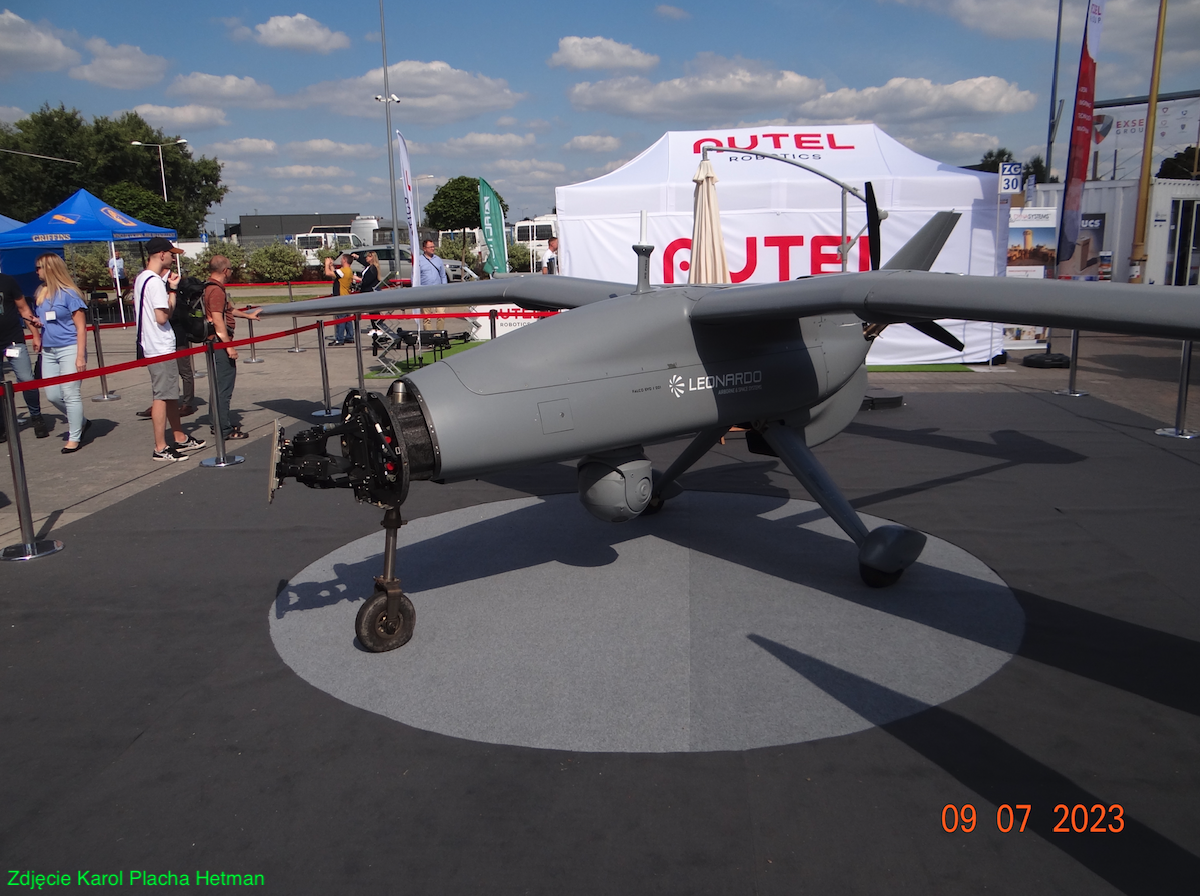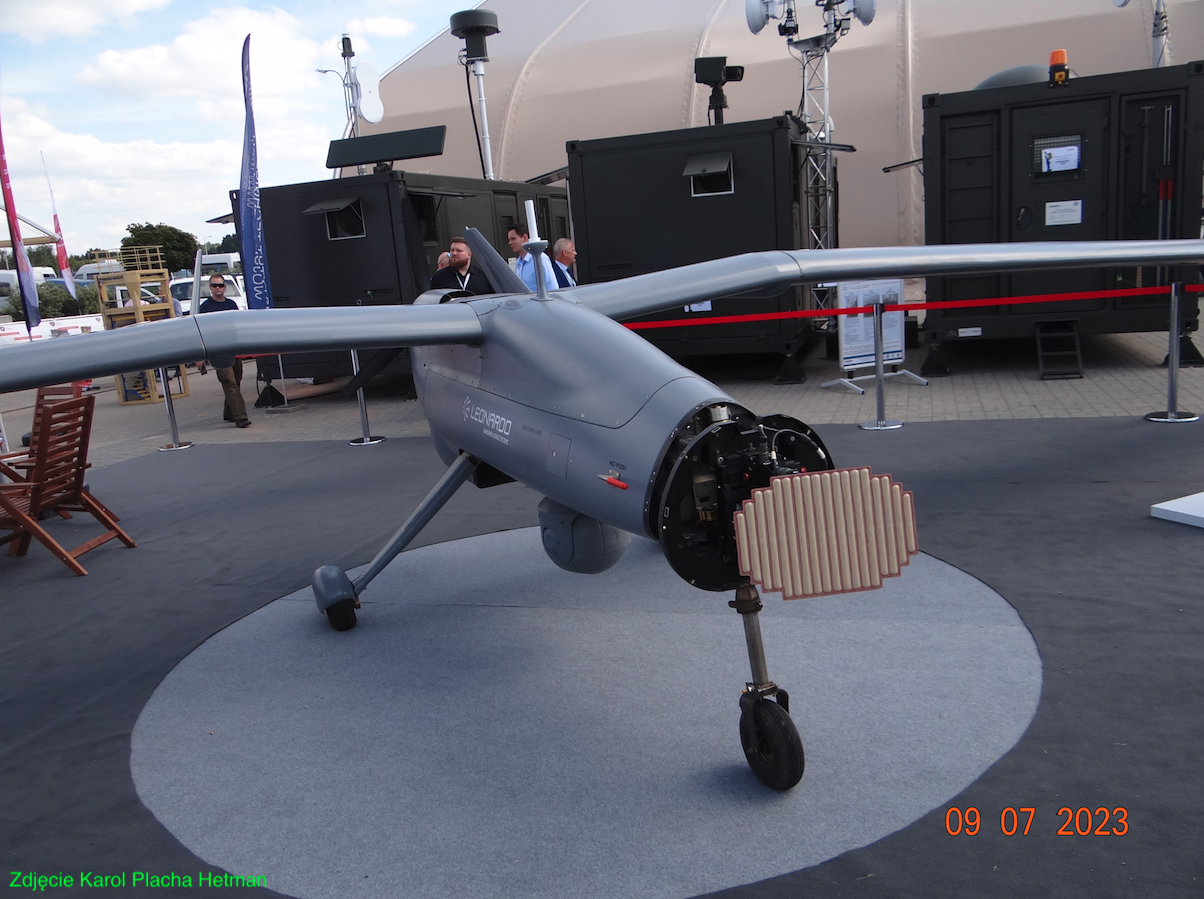Kielce 2023-09-07
Leonardo Falco Evo Unmanned Aerial Vehicle.
The first BAL Falco Evo flight was made in December 2003. The system was started to be developed by Selex ES. The system was introduced into use in 2009. Selex ES, then acquired by Galileo Avionica, then Leonardo-Finmeccanica and Finmeccanica, and now Leonardo. Unmanned Aerial Vehicle is a term commonly used in the 1970s. Currently, the name Unmanned Aerial Vehicle (UAV) is more commonly used.



History of construction.
The UAV aircraft was designed as an observation platform operating at medium altitudes, with average tactical and technical data. The UAV aircraft carries a set of different sensors, depending on the missions being performed. During the Italy-Pakistan cooperation, Pakistan's side demanded that the plane be armed. Italy then rejected this proposal.
The UAV prototype made its first flight in December 2003. Validation of the flight control systems was completed in September 2004. Galileo Avionica began testing in December 2004. The radar was installed in 2006. In January 2007, it was announced that Galileo Avionica had completed factory acceptance testing. The first recipient of the system was Pakistan, which participated in some of the work in the program. The first production Falco UAVs received a newer power unit, with a power of 80 HP (60 kW), supplied by UAV Engines.
In March 2009, it was reported that a modified version of the UAV was being offered called Falco Evo, where "evo" stands for evolution. The plane was enlarged almost twice. The wingspan has been increased to 12.5 m. The lifting capacity has been increased from 70 kg to 100 kg.
In 2010, it was known that Pakistan had ordered 5 systems, i.e. a total of 25 UAV aircraft, 5 GCS control stations and the entire security system. Final assembly was carried out in Pakistan. Also in 2010, Pakistan started serial production of the FALCO EVO UAV system and it must be suspected that these will be armed UAV aircraft. Production was carried out by Aeronautical Complex (PAC) in Kamra.
The UAV aircraft is adapted for a classic take-off, with a runway, but launch from a catapult launcher is also used. A Robonic MC2555LLR pneumatic launcher is used.
In 2012, SELEX Galileo, later Selex ES, announced that the Falcon Evo had successfully completed its 40-minute maiden flight from Cheshnegirovo Air Base in Bulgaria.
In 2013, the United Nations purchased the FALCO EVO UAV system for operations in the Democratic Republic of the Congo to monitor the movements of armed gangs and protect civilians.
There are no known other users of the FALCO EVO UAV system. You can guess that these are the countries of the Middle East and North Africa. Users include: Bangladesh, Libya, Jordan, Saudi Arabia, Turkmenia, UN.
Leonardo also offers the system to the Polish Army. If this happened, Leonardo would place the production of Falco EVO in Poland. Unmanned aerial vehicles could be produced at the PZL-Świdnik plant.
System FALCO EVO UAV.
The Falco UAV system includes: Ground Control Station (GCS). Ground Data Terminal (GDT). Ground support equipment (GSE). 3-5 Falco UAV aircraft.
The FALCO EVO UAV system is an Unmanned Aerial Vehicle and a ground component (control station), which is intended mainly for observing the ground situation from the air. FALCO EVO UAV can carry a wide set of sensors that enable: detection, classification, identification and tracking of targets in real time. The system is a valuable intelligence source and information hub, integrated with any national C4I network. The system has high efficiency, durability, range and the ability to operate day and night. Communication between the UAV aircraft and the control station is ensured over a distance of 200 km. But if satellite communication is used, the range increases significantly.
A typical system configuration includes a Ground Control Station (GCS), connected to a Ground Data Terminal (GDT), Ground Support Equipment (GSE) and typically 3-5 Unmanned Aerial Vehicles. The system operates in land, coastal and marine environments. The system can perform the assigned task 24 hours a day, 7 days a week. The flying apparatus itself can move in almost any weather conditions. The system can perform military, paramilitary, police, border guard, coast guard tasks, environmental monitoring, forest and crop control, maritime economy, energy (control of transmission lines and pipelines), and support activities after disasters and accidents.
The system can carry a wide range of mission sensors, including electro-optical (EO), infrared (IR), laser rangefinders (LRF), laser designators (LD), synthetic aperture radar (SAR), passive and active electronic warfare (EW) ). The Selex ES Gabbiano radar, which is used in the Falco UAV aircraft, was also ordered by Elbit from Israel for its Hermes 450 and 900 UAVs. In combat missions, the system can use weapons in the form of bombs, unguided missiles and guided missiles.
The Unmanned Aerial Vehicle can take off and land automatically. It can fly along a set route. Can track automatic moving targets. Individual aircraft can transmit the acquired information among themselves and send it collectively to the control station.
The FALCO EVO UAV system can be adapted to the customer's needs, i.e. standard customer needs.
Ground Control Station (control station) (GCS).
The FALCO/FALCO EVO ground control station enables mission planning and rehearsal, pre-flight system checks, mission management, flight plan task changes, mission replay and simulation for operator training. The surveillance flight plan typically follows a programmed route automatically, including take-off and landing phases, with the option to manually change settings at any time during the flight.
The Ground Control Station has the ability to evaluate and process target data off-line for further distribution over the C4I network in the STANAG 4609 format. The Ground Data Terminal provides real-time data link coverage over a distance exceeding 200 km between the Ground Control Station and FALCO EVO aircraft. Using satellite communications, the range increases significantly.
There are: EO/IR/LRF sensors on board the aircraft. Laser marker. Laser designator (LD). SAR (synthetic aperture radar) GMTI. Multimode surveillance radar. AIS (Automatic Identification System). Relay package. Hyperspectral sensor.
The first version of the Falco UAV.
Length 5.25 m (17 ft 2 in). Wingspan 7.30 m (23 ft 7 in). Height 1.80 m (5 ft 11 in). Top speed 216 km/h (134 mph, 116 knots). Operating ceiling 16,400 feet (5,000 m). Maximum ceiling 6,500 m (21,325 ft). Flight time over 14 hours. Load weight up to 70 kg. Total load capacity 150 kg (331 lb). Maximum takeoff weight 750 kg (1,654 lb).
Powertrain 1 × petrol engine, 48 kW (65 HP). It is a diesel engine that can be powered by both diesel oil and Jet A1 aviation turbine engine fuel. If the UAV aircraft was adapted to use weapons, it was equipped with two hooks with a total lifting capacity of up to 70 kg.
The second version of the Falco Evo UAV.
Length 6.20 m. Wingspan 12.5 m. Height 2.5 m. Total weight 650 kg. Flight time over 20 hours. Load weight 100 kg. Flight ceiling 6,000 m. Communication range of the aircraft with the control station is over 200 km.
Power unit: 1 × petrol engine, 80 HP. It is a diesel engine that can be powered by both diesel oil and Jet A1 aviation turbine engine fuel. If the Falco Evo UAV aircraft was adapted to use weapons, it was equipped with two hooks with a total lifting capacity of up to 100-120 kg.
Written by Karol Placha Hetman
